Dissertation: Analysis of Digital Transformation in Construction
VerifiedAdded on 2023/06/18
|64
|17458
|215
Dissertation
AI Summary
This dissertation provides an in-depth analysis of digital transformation strategies within the construction industry, focusing on the UAE market. It begins by defining digital transformation and examining currently available digital technologies and their benefits in construction. The research investigates digital awareness among employees in the UAE and explores the challenges associated with implementing digital transformation strategies. The study employs a positivism research philosophy and a deductive research approach, utilizing questionnaires and construction company interviews to gather data. Key areas explored include human resources, finance, procurement, purchasing, technology, quality control, business development, bid management, contract management, health & safety, technical aspects, and project cost control. The dissertation concludes with a discussion of findings and proposes a digital transformation roadmap, outlining a vision, strategies for people and future-proofing, and methods for current business optimization, including ERP and RPA implementation. The ultimate aim is to highlight obstacles and propose a digital transformation roadmap with appropriate technologies and solutions to implementation challenges.
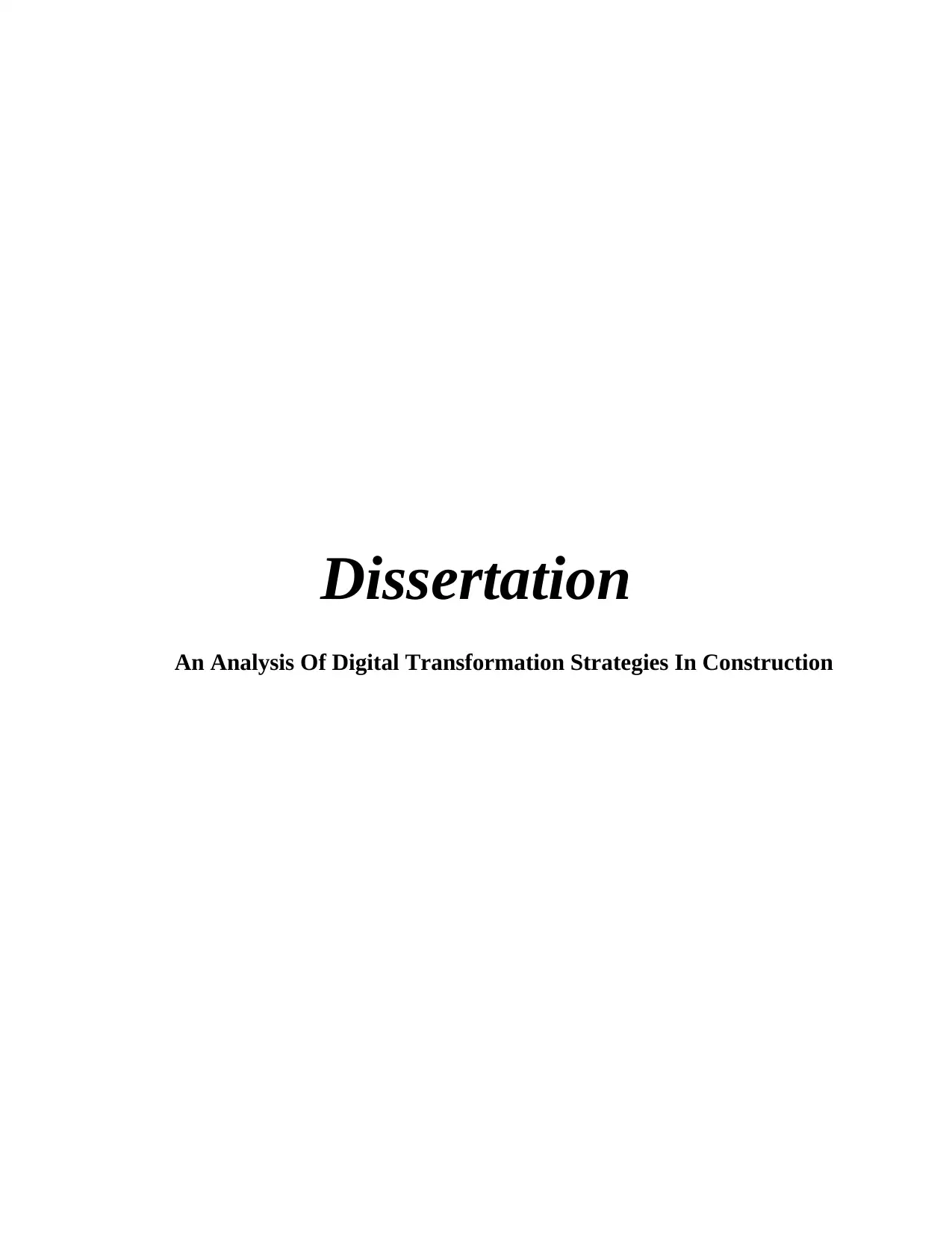
Dissertation
An Analysis Of Digital Transformation Strategies In Construction
An Analysis Of Digital Transformation Strategies In Construction
Paraphrase This Document
Need a fresh take? Get an instant paraphrase of this document with our AI Paraphraser
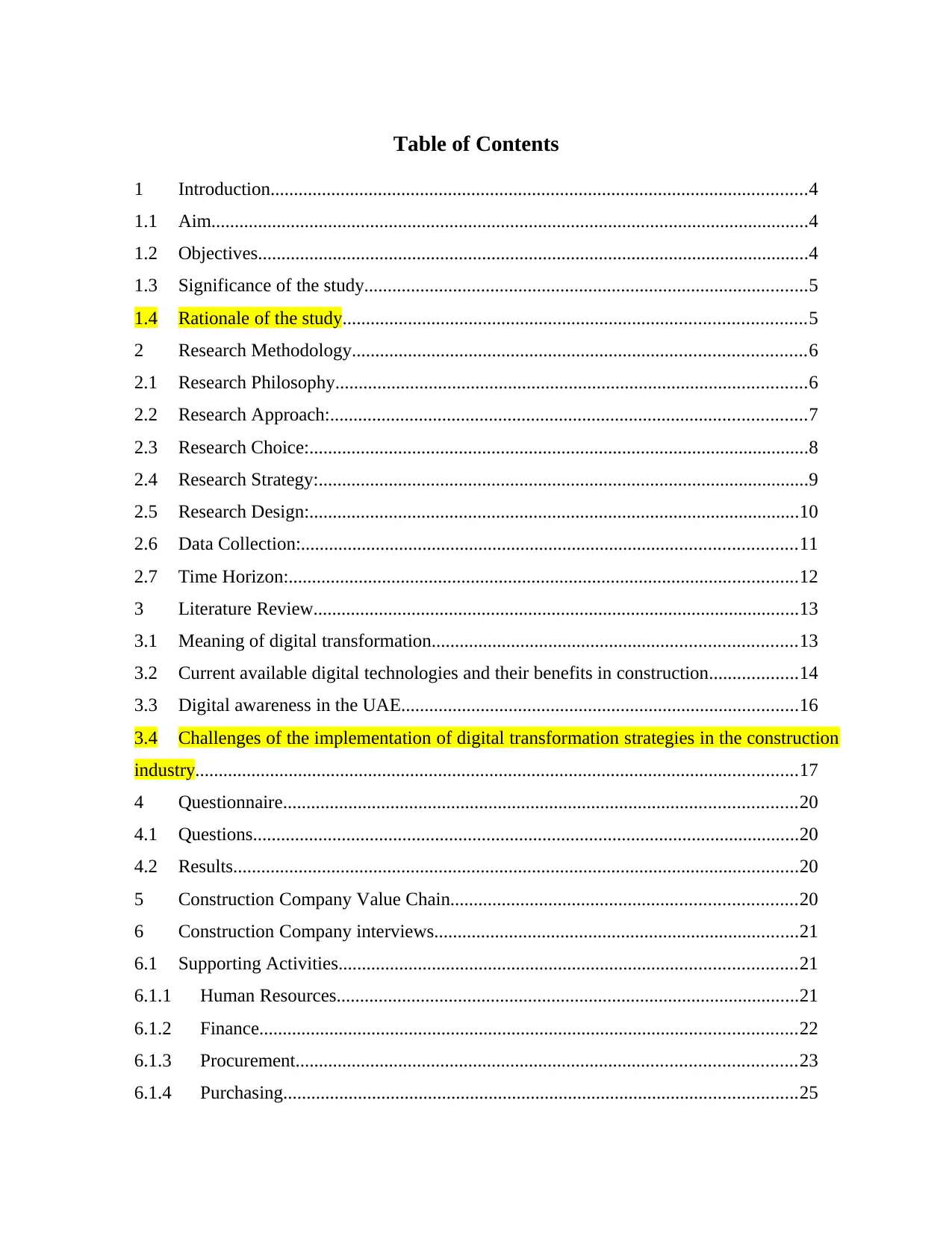
Table of Contents
1 Introduction...................................................................................................................4
1.1 Aim................................................................................................................................4
1.2 Objectives......................................................................................................................4
1.3 Significance of the study...............................................................................................5
1.4 Rationale of the study...................................................................................................5
2 Research Methodology.................................................................................................6
2.1 Research Philosophy.....................................................................................................6
2.2 Research Approach:......................................................................................................7
2.3 Research Choice:...........................................................................................................8
2.4 Research Strategy:.........................................................................................................9
2.5 Research Design:.........................................................................................................10
2.6 Data Collection:..........................................................................................................11
2.7 Time Horizon:.............................................................................................................12
3 Literature Review........................................................................................................13
3.1 Meaning of digital transformation..............................................................................13
3.2 Current available digital technologies and their benefits in construction...................14
3.3 Digital awareness in the UAE.....................................................................................16
3.4 Challenges of the implementation of digital transformation strategies in the construction
industry.................................................................................................................................17
4 Questionnaire..............................................................................................................20
4.1 Questions.....................................................................................................................20
4.2 Results.........................................................................................................................20
5 Construction Company Value Chain..........................................................................20
6 Construction Company interviews..............................................................................21
6.1 Supporting Activities..................................................................................................21
6.1.1 Human Resources...................................................................................................21
6.1.2 Finance...................................................................................................................22
6.1.3 Procurement...........................................................................................................23
6.1.4 Purchasing..............................................................................................................25
1 Introduction...................................................................................................................4
1.1 Aim................................................................................................................................4
1.2 Objectives......................................................................................................................4
1.3 Significance of the study...............................................................................................5
1.4 Rationale of the study...................................................................................................5
2 Research Methodology.................................................................................................6
2.1 Research Philosophy.....................................................................................................6
2.2 Research Approach:......................................................................................................7
2.3 Research Choice:...........................................................................................................8
2.4 Research Strategy:.........................................................................................................9
2.5 Research Design:.........................................................................................................10
2.6 Data Collection:..........................................................................................................11
2.7 Time Horizon:.............................................................................................................12
3 Literature Review........................................................................................................13
3.1 Meaning of digital transformation..............................................................................13
3.2 Current available digital technologies and their benefits in construction...................14
3.3 Digital awareness in the UAE.....................................................................................16
3.4 Challenges of the implementation of digital transformation strategies in the construction
industry.................................................................................................................................17
4 Questionnaire..............................................................................................................20
4.1 Questions.....................................................................................................................20
4.2 Results.........................................................................................................................20
5 Construction Company Value Chain..........................................................................20
6 Construction Company interviews..............................................................................21
6.1 Supporting Activities..................................................................................................21
6.1.1 Human Resources...................................................................................................21
6.1.2 Finance...................................................................................................................22
6.1.3 Procurement...........................................................................................................23
6.1.4 Purchasing..............................................................................................................25
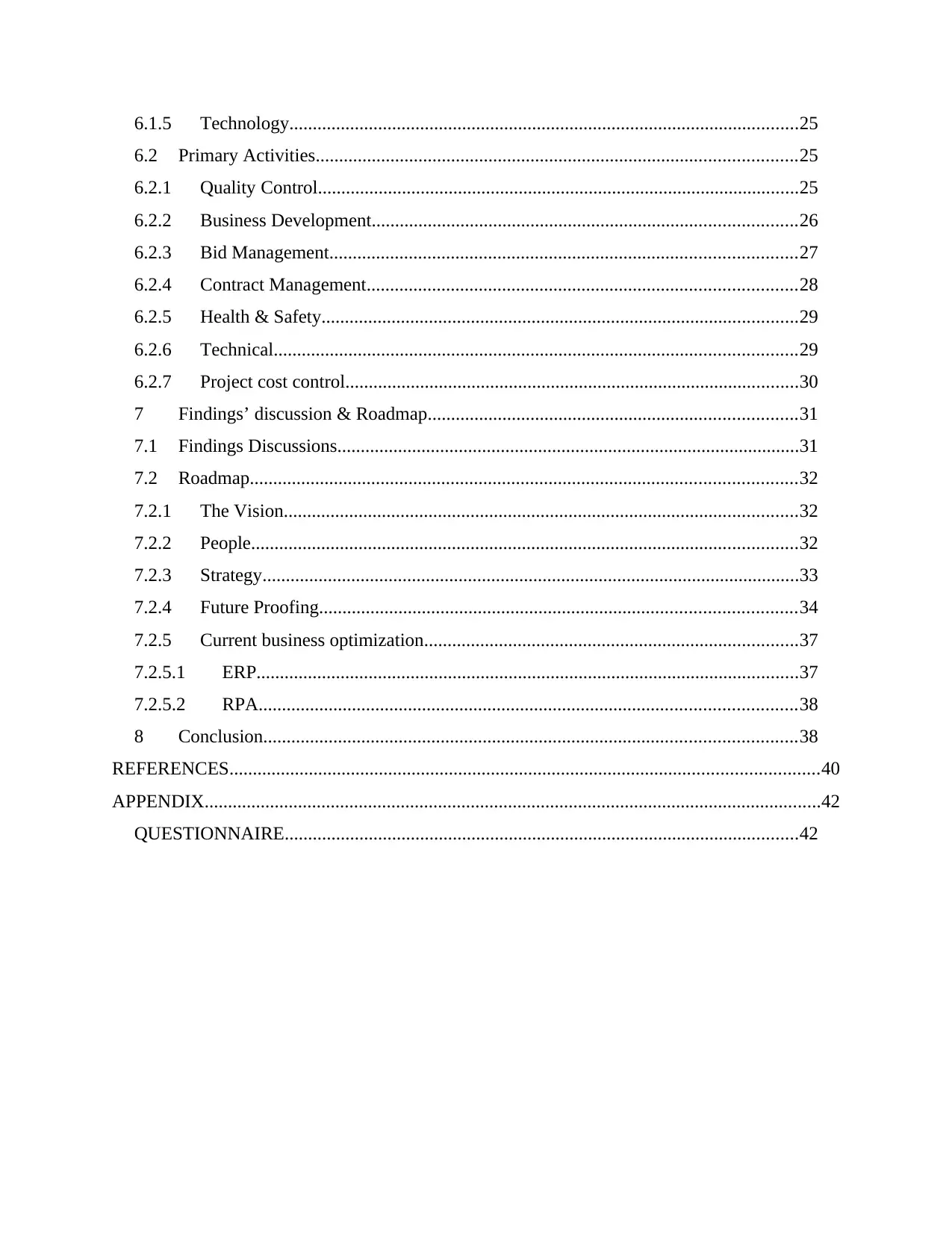
6.1.5 Technology.............................................................................................................25
6.2 Primary Activities.......................................................................................................25
6.2.1 Quality Control.......................................................................................................25
6.2.2 Business Development...........................................................................................26
6.2.3 Bid Management....................................................................................................27
6.2.4 Contract Management............................................................................................28
6.2.5 Health & Safety......................................................................................................29
6.2.6 Technical................................................................................................................29
6.2.7 Project cost control.................................................................................................30
7 Findings’ discussion & Roadmap...............................................................................31
7.1 Findings Discussions...................................................................................................31
7.2 Roadmap.....................................................................................................................32
7.2.1 The Vision..............................................................................................................32
7.2.2 People.....................................................................................................................32
7.2.3 Strategy...................................................................................................................33
7.2.4 Future Proofing......................................................................................................34
7.2.5 Current business optimization................................................................................37
7.2.5.1 ERP....................................................................................................................37
7.2.5.2 RPA...................................................................................................................38
8 Conclusion..................................................................................................................38
REFERENCES..............................................................................................................................40
APPENDIX....................................................................................................................................42
QUESTIONNAIRE..............................................................................................................42
6.2 Primary Activities.......................................................................................................25
6.2.1 Quality Control.......................................................................................................25
6.2.2 Business Development...........................................................................................26
6.2.3 Bid Management....................................................................................................27
6.2.4 Contract Management............................................................................................28
6.2.5 Health & Safety......................................................................................................29
6.2.6 Technical................................................................................................................29
6.2.7 Project cost control.................................................................................................30
7 Findings’ discussion & Roadmap...............................................................................31
7.1 Findings Discussions...................................................................................................31
7.2 Roadmap.....................................................................................................................32
7.2.1 The Vision..............................................................................................................32
7.2.2 People.....................................................................................................................32
7.2.3 Strategy...................................................................................................................33
7.2.4 Future Proofing......................................................................................................34
7.2.5 Current business optimization................................................................................37
7.2.5.1 ERP....................................................................................................................37
7.2.5.2 RPA...................................................................................................................38
8 Conclusion..................................................................................................................38
REFERENCES..............................................................................................................................40
APPENDIX....................................................................................................................................42
QUESTIONNAIRE..............................................................................................................42
⊘ This is a preview!⊘
Do you want full access?
Subscribe today to unlock all pages.

Trusted by 1+ million students worldwide
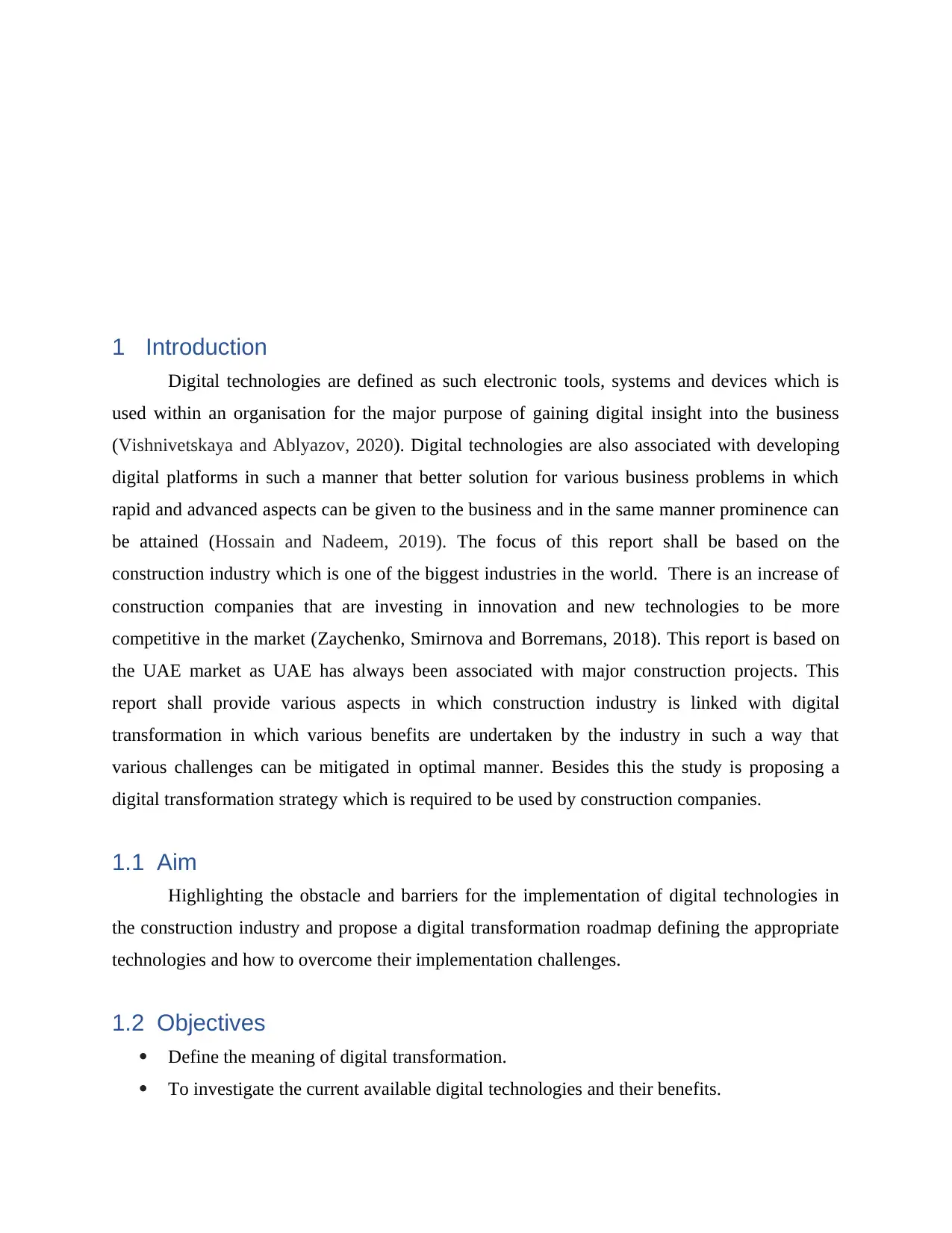
1 Introduction
Digital technologies are defined as such electronic tools, systems and devices which is
used within an organisation for the major purpose of gaining digital insight into the business
(Vishnivetskaya and Ablyazov, 2020). Digital technologies are also associated with developing
digital platforms in such a manner that better solution for various business problems in which
rapid and advanced aspects can be given to the business and in the same manner prominence can
be attained (Hossain and Nadeem, 2019). The focus of this report shall be based on the
construction industry which is one of the biggest industries in the world. There is an increase of
construction companies that are investing in innovation and new technologies to be more
competitive in the market (Zaychenko, Smirnova and Borremans, 2018). This report is based on
the UAE market as UAE has always been associated with major construction projects. This
report shall provide various aspects in which construction industry is linked with digital
transformation in which various benefits are undertaken by the industry in such a way that
various challenges can be mitigated in optimal manner. Besides this the study is proposing a
digital transformation strategy which is required to be used by construction companies.
1.1 Aim
Highlighting the obstacle and barriers for the implementation of digital technologies in
the construction industry and propose a digital transformation roadmap defining the appropriate
technologies and how to overcome their implementation challenges.
1.2 Objectives
Define the meaning of digital transformation.
To investigate the current available digital technologies and their benefits.
Digital technologies are defined as such electronic tools, systems and devices which is
used within an organisation for the major purpose of gaining digital insight into the business
(Vishnivetskaya and Ablyazov, 2020). Digital technologies are also associated with developing
digital platforms in such a manner that better solution for various business problems in which
rapid and advanced aspects can be given to the business and in the same manner prominence can
be attained (Hossain and Nadeem, 2019). The focus of this report shall be based on the
construction industry which is one of the biggest industries in the world. There is an increase of
construction companies that are investing in innovation and new technologies to be more
competitive in the market (Zaychenko, Smirnova and Borremans, 2018). This report is based on
the UAE market as UAE has always been associated with major construction projects. This
report shall provide various aspects in which construction industry is linked with digital
transformation in which various benefits are undertaken by the industry in such a way that
various challenges can be mitigated in optimal manner. Besides this the study is proposing a
digital transformation strategy which is required to be used by construction companies.
1.1 Aim
Highlighting the obstacle and barriers for the implementation of digital technologies in
the construction industry and propose a digital transformation roadmap defining the appropriate
technologies and how to overcome their implementation challenges.
1.2 Objectives
Define the meaning of digital transformation.
To investigate the current available digital technologies and their benefits.
Paraphrase This Document
Need a fresh take? Get an instant paraphrase of this document with our AI Paraphraser
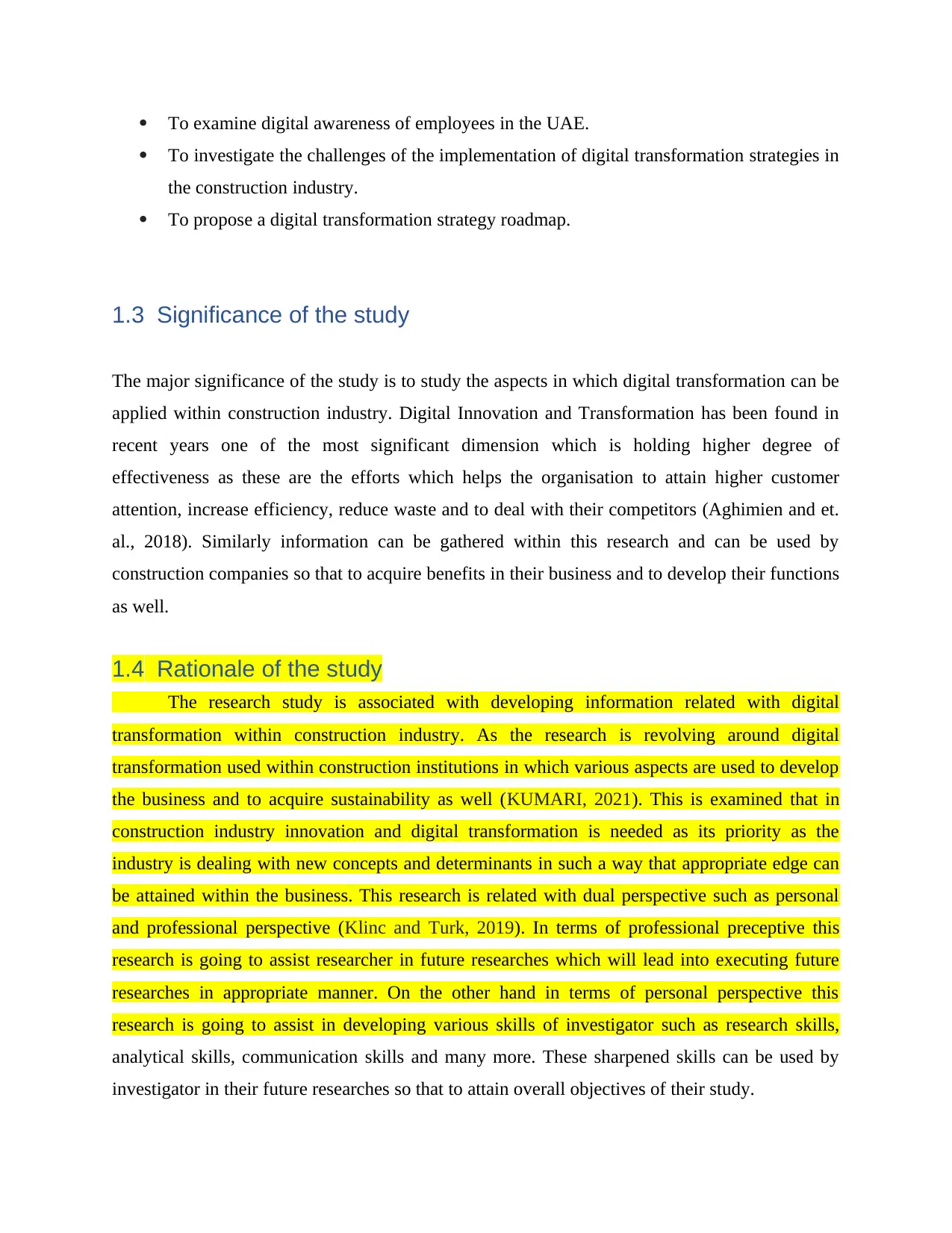
To examine digital awareness of employees in the UAE.
To investigate the challenges of the implementation of digital transformation strategies in
the construction industry.
To propose a digital transformation strategy roadmap.
1.3 Significance of the study
The major significance of the study is to study the aspects in which digital transformation can be
applied within construction industry. Digital Innovation and Transformation has been found in
recent years one of the most significant dimension which is holding higher degree of
effectiveness as these are the efforts which helps the organisation to attain higher customer
attention, increase efficiency, reduce waste and to deal with their competitors (Aghimien and et.
al., 2018). Similarly information can be gathered within this research and can be used by
construction companies so that to acquire benefits in their business and to develop their functions
as well.
1.4 Rationale of the study
The research study is associated with developing information related with digital
transformation within construction industry. As the research is revolving around digital
transformation used within construction institutions in which various aspects are used to develop
the business and to acquire sustainability as well (KUMARI, 2021). This is examined that in
construction industry innovation and digital transformation is needed as its priority as the
industry is dealing with new concepts and determinants in such a way that appropriate edge can
be attained within the business. This research is related with dual perspective such as personal
and professional perspective (Klinc and Turk, 2019). In terms of professional preceptive this
research is going to assist researcher in future researches which will lead into executing future
researches in appropriate manner. On the other hand in terms of personal perspective this
research is going to assist in developing various skills of investigator such as research skills,
analytical skills, communication skills and many more. These sharpened skills can be used by
investigator in their future researches so that to attain overall objectives of their study.
To investigate the challenges of the implementation of digital transformation strategies in
the construction industry.
To propose a digital transformation strategy roadmap.
1.3 Significance of the study
The major significance of the study is to study the aspects in which digital transformation can be
applied within construction industry. Digital Innovation and Transformation has been found in
recent years one of the most significant dimension which is holding higher degree of
effectiveness as these are the efforts which helps the organisation to attain higher customer
attention, increase efficiency, reduce waste and to deal with their competitors (Aghimien and et.
al., 2018). Similarly information can be gathered within this research and can be used by
construction companies so that to acquire benefits in their business and to develop their functions
as well.
1.4 Rationale of the study
The research study is associated with developing information related with digital
transformation within construction industry. As the research is revolving around digital
transformation used within construction institutions in which various aspects are used to develop
the business and to acquire sustainability as well (KUMARI, 2021). This is examined that in
construction industry innovation and digital transformation is needed as its priority as the
industry is dealing with new concepts and determinants in such a way that appropriate edge can
be attained within the business. This research is related with dual perspective such as personal
and professional perspective (Klinc and Turk, 2019). In terms of professional preceptive this
research is going to assist researcher in future researches which will lead into executing future
researches in appropriate manner. On the other hand in terms of personal perspective this
research is going to assist in developing various skills of investigator such as research skills,
analytical skills, communication skills and many more. These sharpened skills can be used by
investigator in their future researches so that to attain overall objectives of their study.
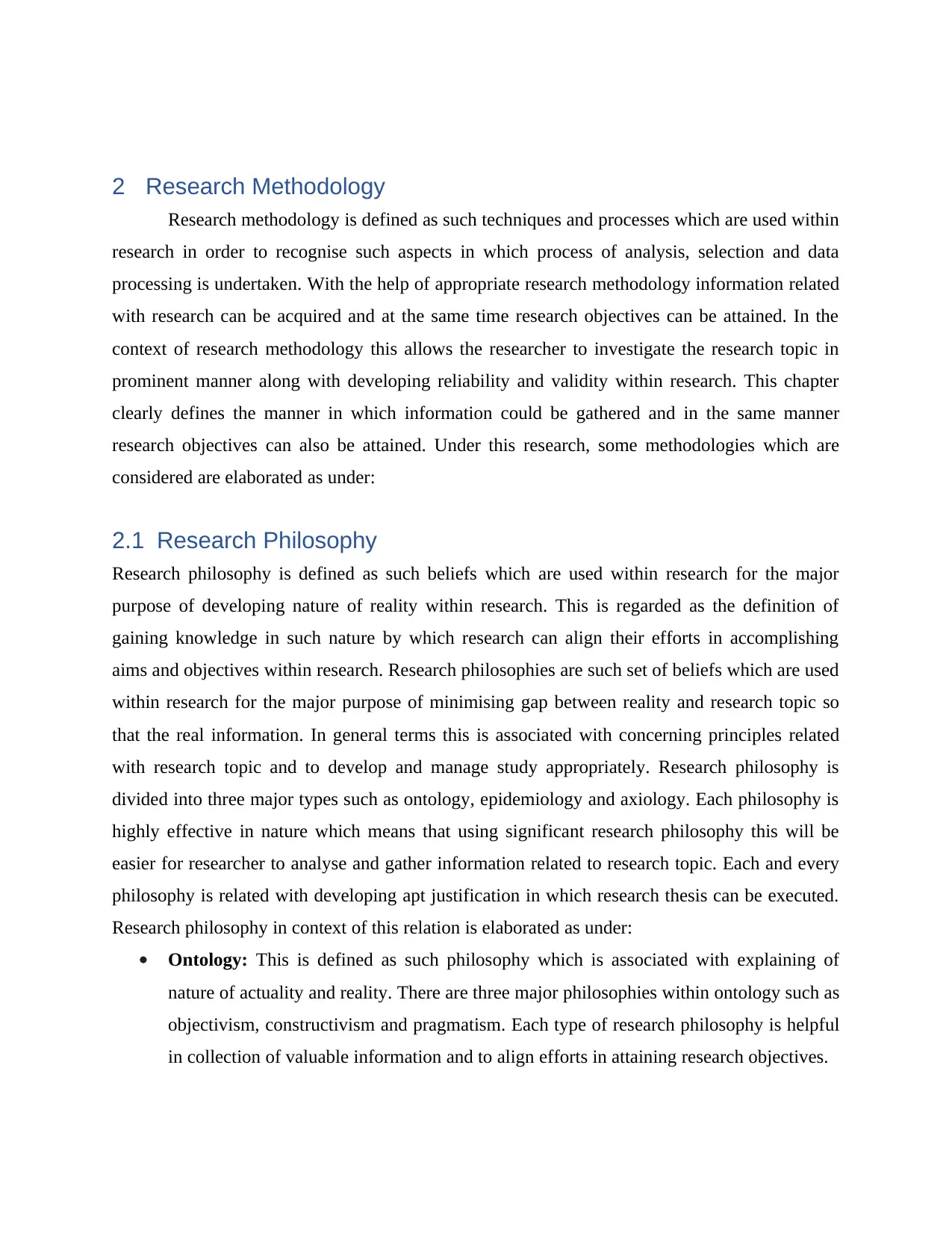
2 Research Methodology
Research methodology is defined as such techniques and processes which are used within
research in order to recognise such aspects in which process of analysis, selection and data
processing is undertaken. With the help of appropriate research methodology information related
with research can be acquired and at the same time research objectives can be attained. In the
context of research methodology this allows the researcher to investigate the research topic in
prominent manner along with developing reliability and validity within research. This chapter
clearly defines the manner in which information could be gathered and in the same manner
research objectives can also be attained. Under this research, some methodologies which are
considered are elaborated as under:
2.1 Research Philosophy
Research philosophy is defined as such beliefs which are used within research for the major
purpose of developing nature of reality within research. This is regarded as the definition of
gaining knowledge in such nature by which research can align their efforts in accomplishing
aims and objectives within research. Research philosophies are such set of beliefs which are used
within research for the major purpose of minimising gap between reality and research topic so
that the real information. In general terms this is associated with concerning principles related
with research topic and to develop and manage study appropriately. Research philosophy is
divided into three major types such as ontology, epidemiology and axiology. Each philosophy is
highly effective in nature which means that using significant research philosophy this will be
easier for researcher to analyse and gather information related to research topic. Each and every
philosophy is related with developing apt justification in which research thesis can be executed.
Research philosophy in context of this relation is elaborated as under:
Ontology: This is defined as such philosophy which is associated with explaining of
nature of actuality and reality. There are three major philosophies within ontology such as
objectivism, constructivism and pragmatism. Each type of research philosophy is helpful
in collection of valuable information and to align efforts in attaining research objectives.
Research methodology is defined as such techniques and processes which are used within
research in order to recognise such aspects in which process of analysis, selection and data
processing is undertaken. With the help of appropriate research methodology information related
with research can be acquired and at the same time research objectives can be attained. In the
context of research methodology this allows the researcher to investigate the research topic in
prominent manner along with developing reliability and validity within research. This chapter
clearly defines the manner in which information could be gathered and in the same manner
research objectives can also be attained. Under this research, some methodologies which are
considered are elaborated as under:
2.1 Research Philosophy
Research philosophy is defined as such beliefs which are used within research for the major
purpose of developing nature of reality within research. This is regarded as the definition of
gaining knowledge in such nature by which research can align their efforts in accomplishing
aims and objectives within research. Research philosophies are such set of beliefs which are used
within research for the major purpose of minimising gap between reality and research topic so
that the real information. In general terms this is associated with concerning principles related
with research topic and to develop and manage study appropriately. Research philosophy is
divided into three major types such as ontology, epidemiology and axiology. Each philosophy is
highly effective in nature which means that using significant research philosophy this will be
easier for researcher to analyse and gather information related to research topic. Each and every
philosophy is related with developing apt justification in which research thesis can be executed.
Research philosophy in context of this relation is elaborated as under:
Ontology: This is defined as such philosophy which is associated with explaining of
nature of actuality and reality. There are three major philosophies within ontology such as
objectivism, constructivism and pragmatism. Each type of research philosophy is helpful
in collection of valuable information and to align efforts in attaining research objectives.
⊘ This is a preview!⊘
Do you want full access?
Subscribe today to unlock all pages.

Trusted by 1+ million students worldwide
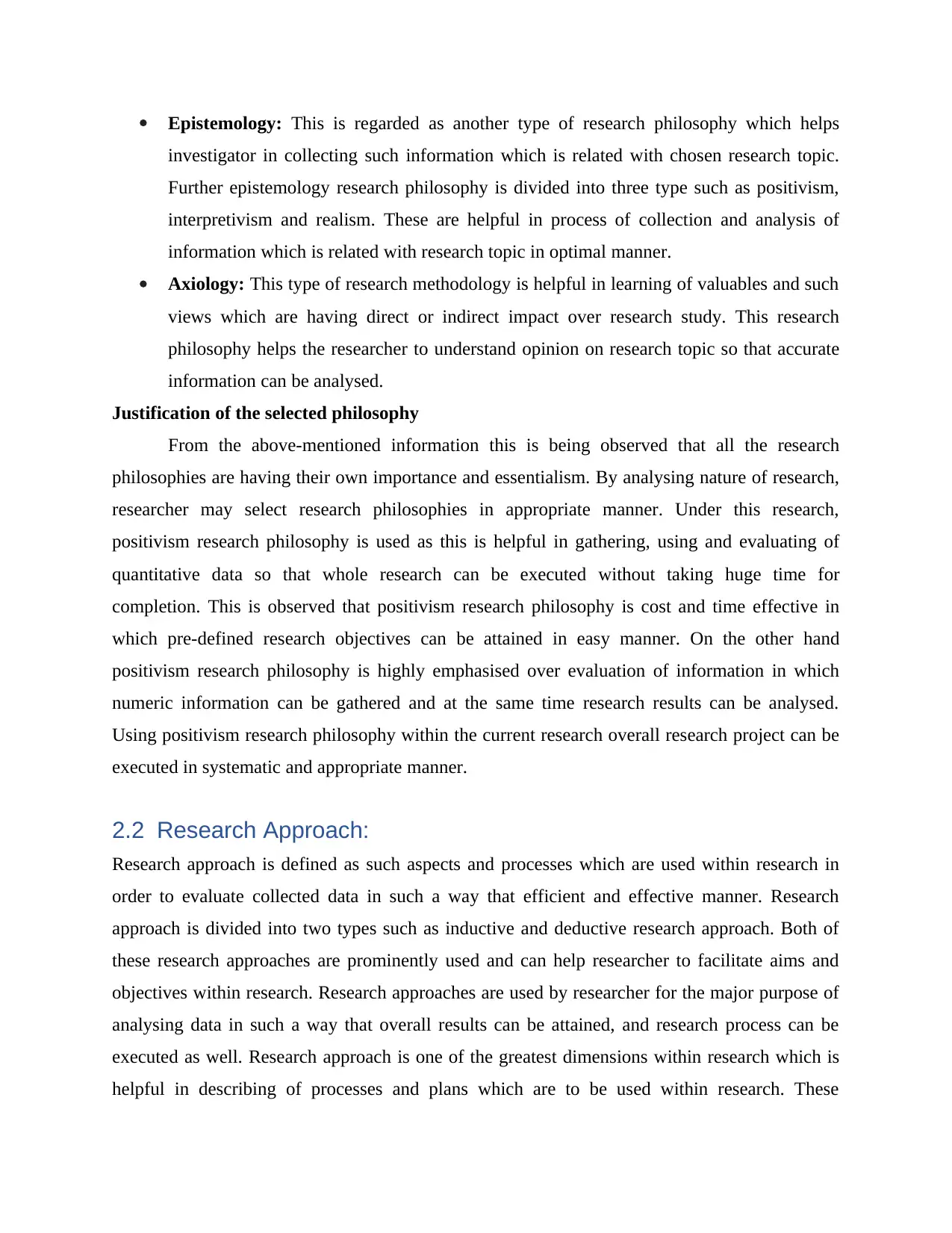
Epistemology: This is regarded as another type of research philosophy which helps
investigator in collecting such information which is related with chosen research topic.
Further epistemology research philosophy is divided into three type such as positivism,
interpretivism and realism. These are helpful in process of collection and analysis of
information which is related with research topic in optimal manner.
Axiology: This type of research methodology is helpful in learning of valuables and such
views which are having direct or indirect impact over research study. This research
philosophy helps the researcher to understand opinion on research topic so that accurate
information can be analysed.
Justification of the selected philosophy
From the above-mentioned information this is being observed that all the research
philosophies are having their own importance and essentialism. By analysing nature of research,
researcher may select research philosophies in appropriate manner. Under this research,
positivism research philosophy is used as this is helpful in gathering, using and evaluating of
quantitative data so that whole research can be executed without taking huge time for
completion. This is observed that positivism research philosophy is cost and time effective in
which pre-defined research objectives can be attained in easy manner. On the other hand
positivism research philosophy is highly emphasised over evaluation of information in which
numeric information can be gathered and at the same time research results can be analysed.
Using positivism research philosophy within the current research overall research project can be
executed in systematic and appropriate manner.
2.2 Research Approach:
Research approach is defined as such aspects and processes which are used within research in
order to evaluate collected data in such a way that efficient and effective manner. Research
approach is divided into two types such as inductive and deductive research approach. Both of
these research approaches are prominently used and can help researcher to facilitate aims and
objectives within research. Research approaches are used by researcher for the major purpose of
analysing data in such a way that overall results can be attained, and research process can be
executed as well. Research approach is one of the greatest dimensions within research which is
helpful in describing of processes and plans which are to be used within research. These
investigator in collecting such information which is related with chosen research topic.
Further epistemology research philosophy is divided into three type such as positivism,
interpretivism and realism. These are helpful in process of collection and analysis of
information which is related with research topic in optimal manner.
Axiology: This type of research methodology is helpful in learning of valuables and such
views which are having direct or indirect impact over research study. This research
philosophy helps the researcher to understand opinion on research topic so that accurate
information can be analysed.
Justification of the selected philosophy
From the above-mentioned information this is being observed that all the research
philosophies are having their own importance and essentialism. By analysing nature of research,
researcher may select research philosophies in appropriate manner. Under this research,
positivism research philosophy is used as this is helpful in gathering, using and evaluating of
quantitative data so that whole research can be executed without taking huge time for
completion. This is observed that positivism research philosophy is cost and time effective in
which pre-defined research objectives can be attained in easy manner. On the other hand
positivism research philosophy is highly emphasised over evaluation of information in which
numeric information can be gathered and at the same time research results can be analysed.
Using positivism research philosophy within the current research overall research project can be
executed in systematic and appropriate manner.
2.2 Research Approach:
Research approach is defined as such aspects and processes which are used within research in
order to evaluate collected data in such a way that efficient and effective manner. Research
approach is divided into two types such as inductive and deductive research approach. Both of
these research approaches are prominently used and can help researcher to facilitate aims and
objectives within research. Research approaches are used by researcher for the major purpose of
analysing data in such a way that overall results can be attained, and research process can be
executed as well. Research approach is one of the greatest dimensions within research which is
helpful in describing of processes and plans which are to be used within research. These
Paraphrase This Document
Need a fresh take? Get an instant paraphrase of this document with our AI Paraphraser
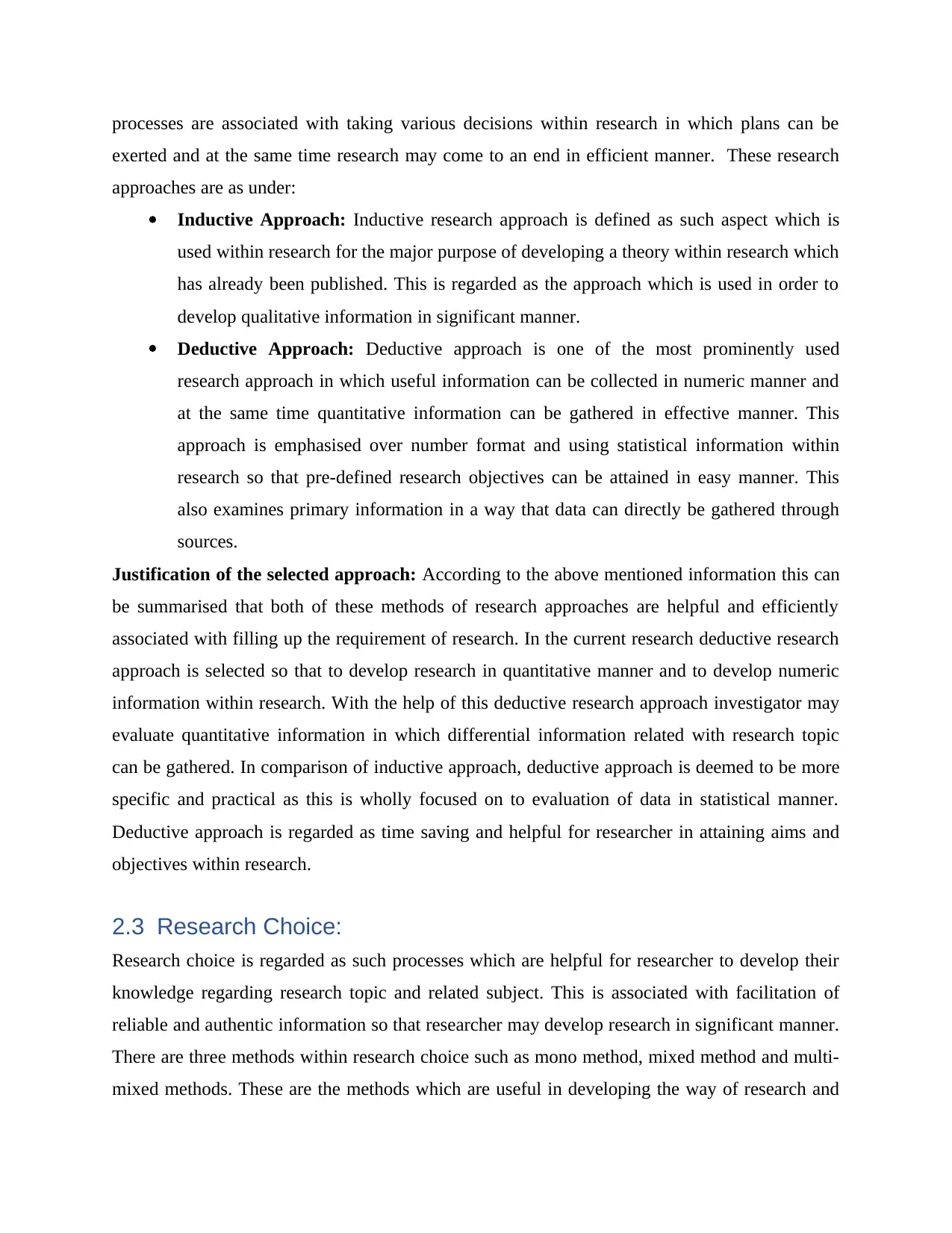
processes are associated with taking various decisions within research in which plans can be
exerted and at the same time research may come to an end in efficient manner. These research
approaches are as under:
Inductive Approach: Inductive research approach is defined as such aspect which is
used within research for the major purpose of developing a theory within research which
has already been published. This is regarded as the approach which is used in order to
develop qualitative information in significant manner.
Deductive Approach: Deductive approach is one of the most prominently used
research approach in which useful information can be collected in numeric manner and
at the same time quantitative information can be gathered in effective manner. This
approach is emphasised over number format and using statistical information within
research so that pre-defined research objectives can be attained in easy manner. This
also examines primary information in a way that data can directly be gathered through
sources.
Justification of the selected approach: According to the above mentioned information this can
be summarised that both of these methods of research approaches are helpful and efficiently
associated with filling up the requirement of research. In the current research deductive research
approach is selected so that to develop research in quantitative manner and to develop numeric
information within research. With the help of this deductive research approach investigator may
evaluate quantitative information in which differential information related with research topic
can be gathered. In comparison of inductive approach, deductive approach is deemed to be more
specific and practical as this is wholly focused on to evaluation of data in statistical manner.
Deductive approach is regarded as time saving and helpful for researcher in attaining aims and
objectives within research.
2.3 Research Choice:
Research choice is regarded as such processes which are helpful for researcher to develop their
knowledge regarding research topic and related subject. This is associated with facilitation of
reliable and authentic information so that researcher may develop research in significant manner.
There are three methods within research choice such as mono method, mixed method and multi-
mixed methods. These are the methods which are useful in developing the way of research and
exerted and at the same time research may come to an end in efficient manner. These research
approaches are as under:
Inductive Approach: Inductive research approach is defined as such aspect which is
used within research for the major purpose of developing a theory within research which
has already been published. This is regarded as the approach which is used in order to
develop qualitative information in significant manner.
Deductive Approach: Deductive approach is one of the most prominently used
research approach in which useful information can be collected in numeric manner and
at the same time quantitative information can be gathered in effective manner. This
approach is emphasised over number format and using statistical information within
research so that pre-defined research objectives can be attained in easy manner. This
also examines primary information in a way that data can directly be gathered through
sources.
Justification of the selected approach: According to the above mentioned information this can
be summarised that both of these methods of research approaches are helpful and efficiently
associated with filling up the requirement of research. In the current research deductive research
approach is selected so that to develop research in quantitative manner and to develop numeric
information within research. With the help of this deductive research approach investigator may
evaluate quantitative information in which differential information related with research topic
can be gathered. In comparison of inductive approach, deductive approach is deemed to be more
specific and practical as this is wholly focused on to evaluation of data in statistical manner.
Deductive approach is regarded as time saving and helpful for researcher in attaining aims and
objectives within research.
2.3 Research Choice:
Research choice is regarded as such processes which are helpful for researcher to develop their
knowledge regarding research topic and related subject. This is associated with facilitation of
reliable and authentic information so that researcher may develop research in significant manner.
There are three methods within research choice such as mono method, mixed method and multi-
mixed methods. These are the methods which are useful in developing the way of research and
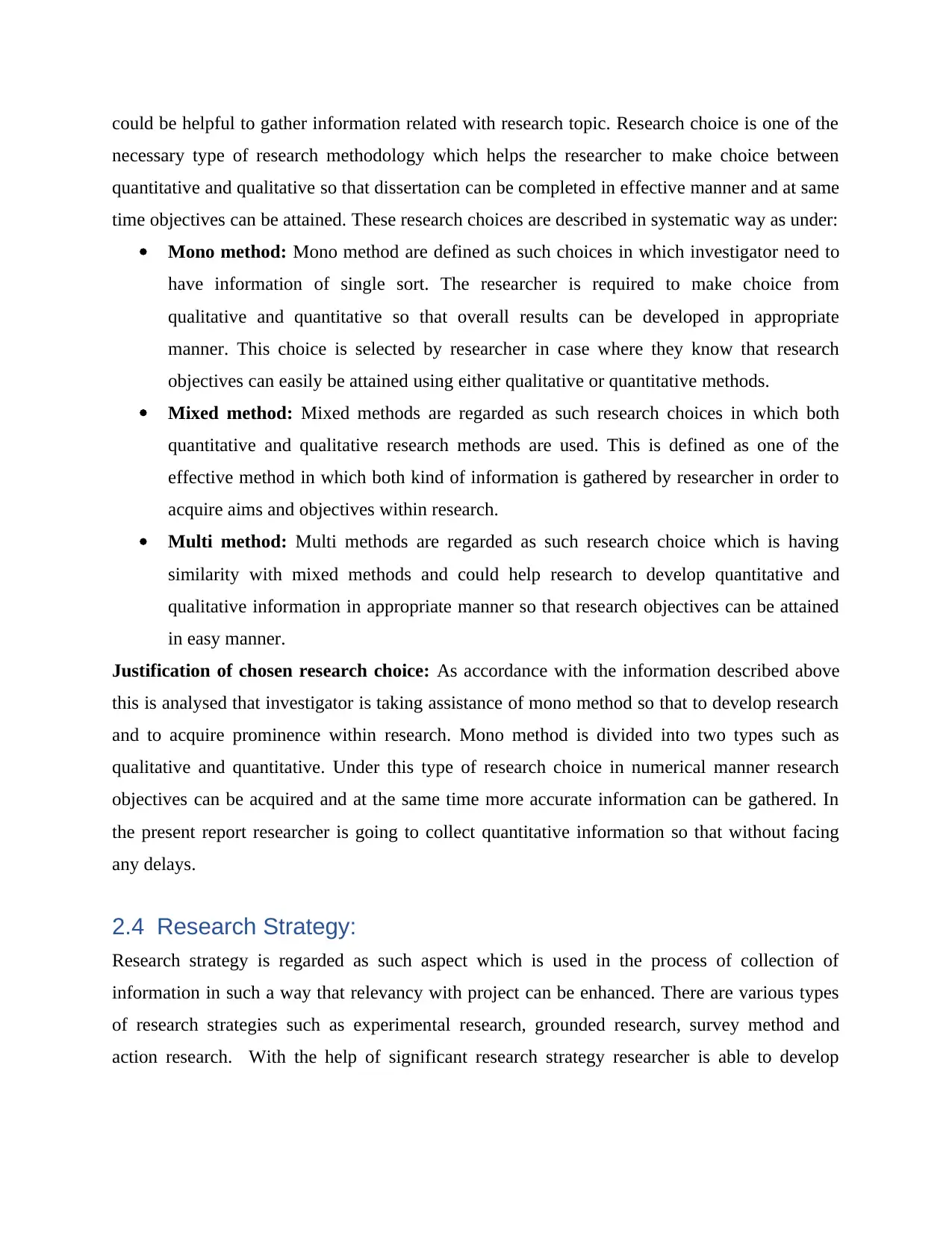
could be helpful to gather information related with research topic. Research choice is one of the
necessary type of research methodology which helps the researcher to make choice between
quantitative and qualitative so that dissertation can be completed in effective manner and at same
time objectives can be attained. These research choices are described in systematic way as under:
Mono method: Mono method are defined as such choices in which investigator need to
have information of single sort. The researcher is required to make choice from
qualitative and quantitative so that overall results can be developed in appropriate
manner. This choice is selected by researcher in case where they know that research
objectives can easily be attained using either qualitative or quantitative methods.
Mixed method: Mixed methods are regarded as such research choices in which both
quantitative and qualitative research methods are used. This is defined as one of the
effective method in which both kind of information is gathered by researcher in order to
acquire aims and objectives within research.
Multi method: Multi methods are regarded as such research choice which is having
similarity with mixed methods and could help research to develop quantitative and
qualitative information in appropriate manner so that research objectives can be attained
in easy manner.
Justification of chosen research choice: As accordance with the information described above
this is analysed that investigator is taking assistance of mono method so that to develop research
and to acquire prominence within research. Mono method is divided into two types such as
qualitative and quantitative. Under this type of research choice in numerical manner research
objectives can be acquired and at the same time more accurate information can be gathered. In
the present report researcher is going to collect quantitative information so that without facing
any delays.
2.4 Research Strategy:
Research strategy is regarded as such aspect which is used in the process of collection of
information in such a way that relevancy with project can be enhanced. There are various types
of research strategies such as experimental research, grounded research, survey method and
action research. With the help of significant research strategy researcher is able to develop
necessary type of research methodology which helps the researcher to make choice between
quantitative and qualitative so that dissertation can be completed in effective manner and at same
time objectives can be attained. These research choices are described in systematic way as under:
Mono method: Mono method are defined as such choices in which investigator need to
have information of single sort. The researcher is required to make choice from
qualitative and quantitative so that overall results can be developed in appropriate
manner. This choice is selected by researcher in case where they know that research
objectives can easily be attained using either qualitative or quantitative methods.
Mixed method: Mixed methods are regarded as such research choices in which both
quantitative and qualitative research methods are used. This is defined as one of the
effective method in which both kind of information is gathered by researcher in order to
acquire aims and objectives within research.
Multi method: Multi methods are regarded as such research choice which is having
similarity with mixed methods and could help research to develop quantitative and
qualitative information in appropriate manner so that research objectives can be attained
in easy manner.
Justification of chosen research choice: As accordance with the information described above
this is analysed that investigator is taking assistance of mono method so that to develop research
and to acquire prominence within research. Mono method is divided into two types such as
qualitative and quantitative. Under this type of research choice in numerical manner research
objectives can be acquired and at the same time more accurate information can be gathered. In
the present report researcher is going to collect quantitative information so that without facing
any delays.
2.4 Research Strategy:
Research strategy is regarded as such aspect which is used in the process of collection of
information in such a way that relevancy with project can be enhanced. There are various types
of research strategies such as experimental research, grounded research, survey method and
action research. With the help of significant research strategy researcher is able to develop
⊘ This is a preview!⊘
Do you want full access?
Subscribe today to unlock all pages.

Trusted by 1+ million students worldwide
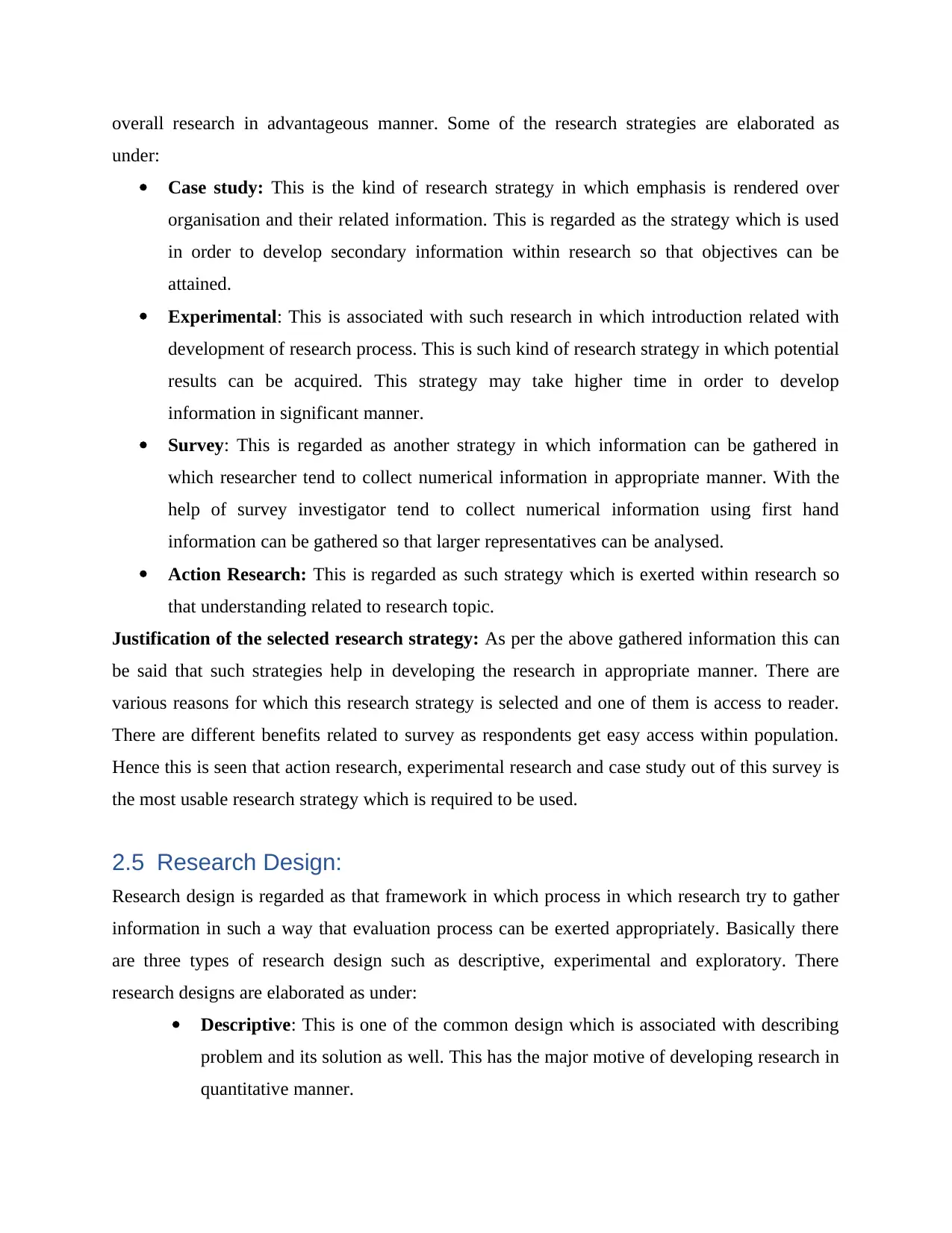
overall research in advantageous manner. Some of the research strategies are elaborated as
under:
Case study: This is the kind of research strategy in which emphasis is rendered over
organisation and their related information. This is regarded as the strategy which is used
in order to develop secondary information within research so that objectives can be
attained.
Experimental: This is associated with such research in which introduction related with
development of research process. This is such kind of research strategy in which potential
results can be acquired. This strategy may take higher time in order to develop
information in significant manner.
Survey: This is regarded as another strategy in which information can be gathered in
which researcher tend to collect numerical information in appropriate manner. With the
help of survey investigator tend to collect numerical information using first hand
information can be gathered so that larger representatives can be analysed.
Action Research: This is regarded as such strategy which is exerted within research so
that understanding related to research topic.
Justification of the selected research strategy: As per the above gathered information this can
be said that such strategies help in developing the research in appropriate manner. There are
various reasons for which this research strategy is selected and one of them is access to reader.
There are different benefits related to survey as respondents get easy access within population.
Hence this is seen that action research, experimental research and case study out of this survey is
the most usable research strategy which is required to be used.
2.5 Research Design:
Research design is regarded as that framework in which process in which research try to gather
information in such a way that evaluation process can be exerted appropriately. Basically there
are three types of research design such as descriptive, experimental and exploratory. There
research designs are elaborated as under:
Descriptive: This is one of the common design which is associated with describing
problem and its solution as well. This has the major motive of developing research in
quantitative manner.
under:
Case study: This is the kind of research strategy in which emphasis is rendered over
organisation and their related information. This is regarded as the strategy which is used
in order to develop secondary information within research so that objectives can be
attained.
Experimental: This is associated with such research in which introduction related with
development of research process. This is such kind of research strategy in which potential
results can be acquired. This strategy may take higher time in order to develop
information in significant manner.
Survey: This is regarded as another strategy in which information can be gathered in
which researcher tend to collect numerical information in appropriate manner. With the
help of survey investigator tend to collect numerical information using first hand
information can be gathered so that larger representatives can be analysed.
Action Research: This is regarded as such strategy which is exerted within research so
that understanding related to research topic.
Justification of the selected research strategy: As per the above gathered information this can
be said that such strategies help in developing the research in appropriate manner. There are
various reasons for which this research strategy is selected and one of them is access to reader.
There are different benefits related to survey as respondents get easy access within population.
Hence this is seen that action research, experimental research and case study out of this survey is
the most usable research strategy which is required to be used.
2.5 Research Design:
Research design is regarded as that framework in which process in which research try to gather
information in such a way that evaluation process can be exerted appropriately. Basically there
are three types of research design such as descriptive, experimental and exploratory. There
research designs are elaborated as under:
Descriptive: This is one of the common design which is associated with describing
problem and its solution as well. This has the major motive of developing research in
quantitative manner.
Paraphrase This Document
Need a fresh take? Get an instant paraphrase of this document with our AI Paraphraser
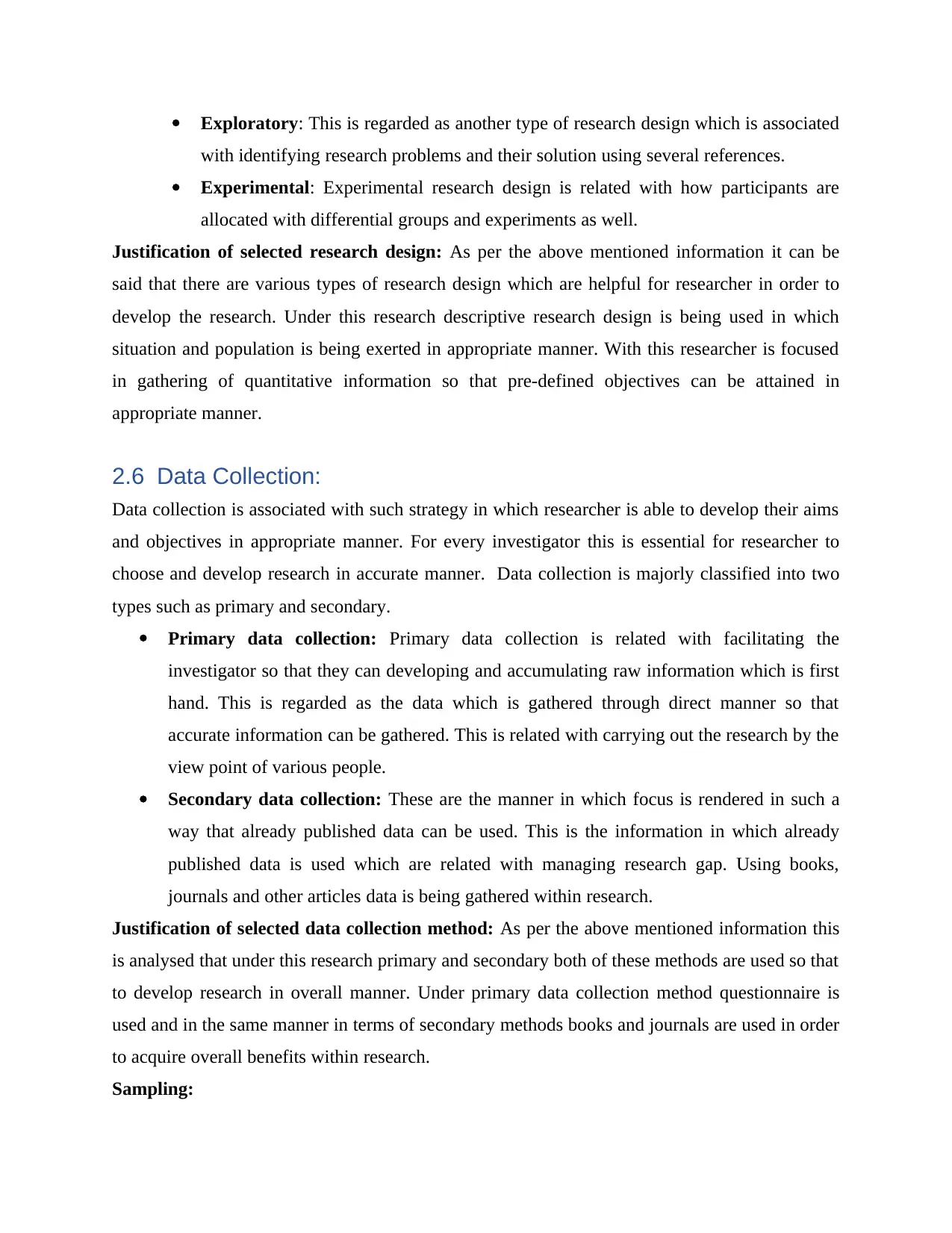
Exploratory: This is regarded as another type of research design which is associated
with identifying research problems and their solution using several references.
Experimental: Experimental research design is related with how participants are
allocated with differential groups and experiments as well.
Justification of selected research design: As per the above mentioned information it can be
said that there are various types of research design which are helpful for researcher in order to
develop the research. Under this research descriptive research design is being used in which
situation and population is being exerted in appropriate manner. With this researcher is focused
in gathering of quantitative information so that pre-defined objectives can be attained in
appropriate manner.
2.6 Data Collection:
Data collection is associated with such strategy in which researcher is able to develop their aims
and objectives in appropriate manner. For every investigator this is essential for researcher to
choose and develop research in accurate manner. Data collection is majorly classified into two
types such as primary and secondary.
Primary data collection: Primary data collection is related with facilitating the
investigator so that they can developing and accumulating raw information which is first
hand. This is regarded as the data which is gathered through direct manner so that
accurate information can be gathered. This is related with carrying out the research by the
view point of various people.
Secondary data collection: These are the manner in which focus is rendered in such a
way that already published data can be used. This is the information in which already
published data is used which are related with managing research gap. Using books,
journals and other articles data is being gathered within research.
Justification of selected data collection method: As per the above mentioned information this
is analysed that under this research primary and secondary both of these methods are used so that
to develop research in overall manner. Under primary data collection method questionnaire is
used and in the same manner in terms of secondary methods books and journals are used in order
to acquire overall benefits within research.
Sampling:
with identifying research problems and their solution using several references.
Experimental: Experimental research design is related with how participants are
allocated with differential groups and experiments as well.
Justification of selected research design: As per the above mentioned information it can be
said that there are various types of research design which are helpful for researcher in order to
develop the research. Under this research descriptive research design is being used in which
situation and population is being exerted in appropriate manner. With this researcher is focused
in gathering of quantitative information so that pre-defined objectives can be attained in
appropriate manner.
2.6 Data Collection:
Data collection is associated with such strategy in which researcher is able to develop their aims
and objectives in appropriate manner. For every investigator this is essential for researcher to
choose and develop research in accurate manner. Data collection is majorly classified into two
types such as primary and secondary.
Primary data collection: Primary data collection is related with facilitating the
investigator so that they can developing and accumulating raw information which is first
hand. This is regarded as the data which is gathered through direct manner so that
accurate information can be gathered. This is related with carrying out the research by the
view point of various people.
Secondary data collection: These are the manner in which focus is rendered in such a
way that already published data can be used. This is the information in which already
published data is used which are related with managing research gap. Using books,
journals and other articles data is being gathered within research.
Justification of selected data collection method: As per the above mentioned information this
is analysed that under this research primary and secondary both of these methods are used so that
to develop research in overall manner. Under primary data collection method questionnaire is
used and in the same manner in terms of secondary methods books and journals are used in order
to acquire overall benefits within research.
Sampling:
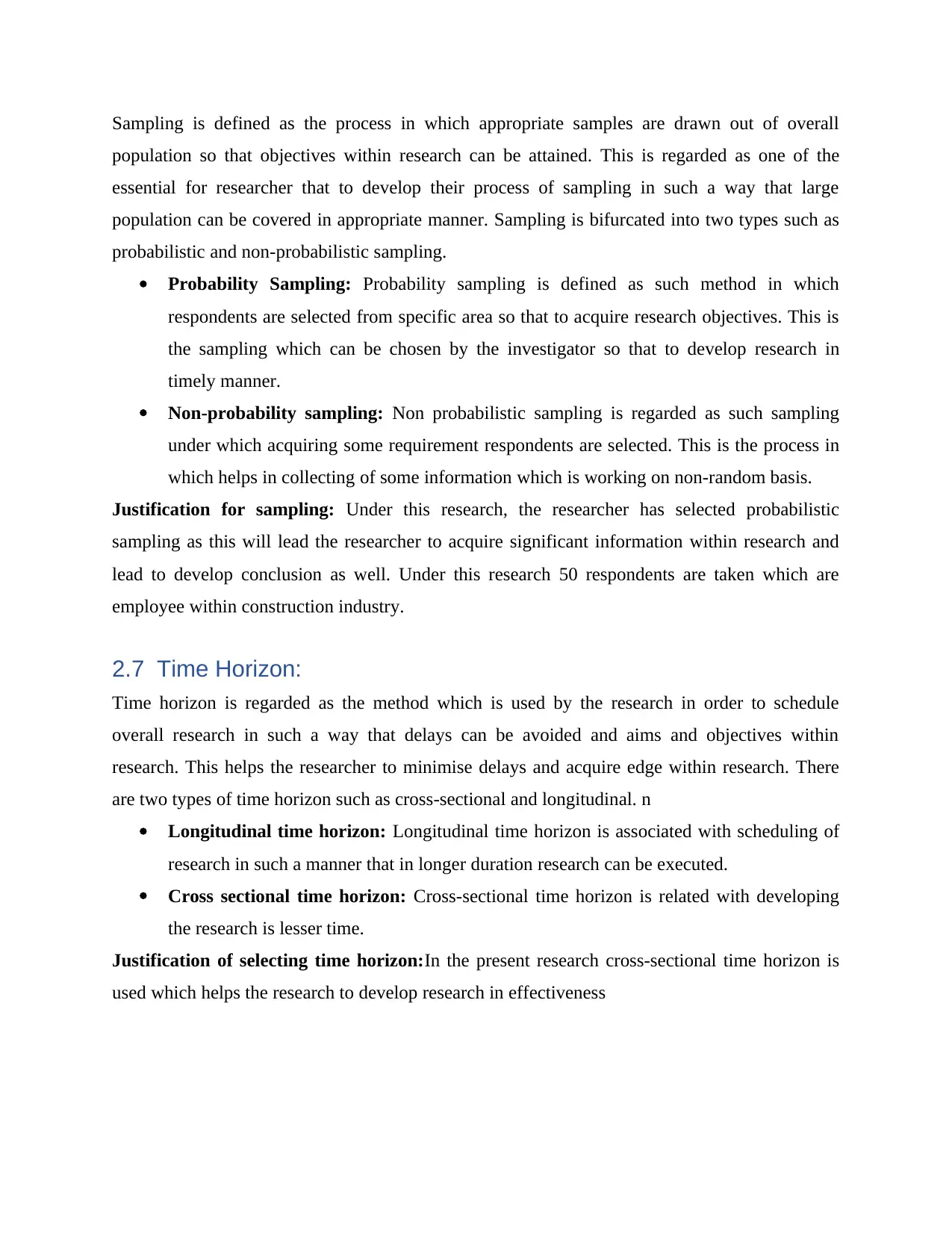
Sampling is defined as the process in which appropriate samples are drawn out of overall
population so that objectives within research can be attained. This is regarded as one of the
essential for researcher that to develop their process of sampling in such a way that large
population can be covered in appropriate manner. Sampling is bifurcated into two types such as
probabilistic and non-probabilistic sampling.
Probability Sampling: Probability sampling is defined as such method in which
respondents are selected from specific area so that to acquire research objectives. This is
the sampling which can be chosen by the investigator so that to develop research in
timely manner.
Non-probability sampling: Non probabilistic sampling is regarded as such sampling
under which acquiring some requirement respondents are selected. This is the process in
which helps in collecting of some information which is working on non-random basis.
Justification for sampling: Under this research, the researcher has selected probabilistic
sampling as this will lead the researcher to acquire significant information within research and
lead to develop conclusion as well. Under this research 50 respondents are taken which are
employee within construction industry.
2.7 Time Horizon:
Time horizon is regarded as the method which is used by the research in order to schedule
overall research in such a way that delays can be avoided and aims and objectives within
research. This helps the researcher to minimise delays and acquire edge within research. There
are two types of time horizon such as cross-sectional and longitudinal. n
Longitudinal time horizon: Longitudinal time horizon is associated with scheduling of
research in such a manner that in longer duration research can be executed.
Cross sectional time horizon: Cross-sectional time horizon is related with developing
the research is lesser time.
Justification of selecting time horizon:In the present research cross-sectional time horizon is
used which helps the research to develop research in effectiveness
population so that objectives within research can be attained. This is regarded as one of the
essential for researcher that to develop their process of sampling in such a way that large
population can be covered in appropriate manner. Sampling is bifurcated into two types such as
probabilistic and non-probabilistic sampling.
Probability Sampling: Probability sampling is defined as such method in which
respondents are selected from specific area so that to acquire research objectives. This is
the sampling which can be chosen by the investigator so that to develop research in
timely manner.
Non-probability sampling: Non probabilistic sampling is regarded as such sampling
under which acquiring some requirement respondents are selected. This is the process in
which helps in collecting of some information which is working on non-random basis.
Justification for sampling: Under this research, the researcher has selected probabilistic
sampling as this will lead the researcher to acquire significant information within research and
lead to develop conclusion as well. Under this research 50 respondents are taken which are
employee within construction industry.
2.7 Time Horizon:
Time horizon is regarded as the method which is used by the research in order to schedule
overall research in such a way that delays can be avoided and aims and objectives within
research. This helps the researcher to minimise delays and acquire edge within research. There
are two types of time horizon such as cross-sectional and longitudinal. n
Longitudinal time horizon: Longitudinal time horizon is associated with scheduling of
research in such a manner that in longer duration research can be executed.
Cross sectional time horizon: Cross-sectional time horizon is related with developing
the research is lesser time.
Justification of selecting time horizon:In the present research cross-sectional time horizon is
used which helps the research to develop research in effectiveness
⊘ This is a preview!⊘
Do you want full access?
Subscribe today to unlock all pages.

Trusted by 1+ million students worldwide
1 out of 64
Related Documents
Your All-in-One AI-Powered Toolkit for Academic Success.
+13062052269
info@desklib.com
Available 24*7 on WhatsApp / Email
![[object Object]](/_next/static/media/star-bottom.7253800d.svg)
Unlock your academic potential
Copyright © 2020–2025 A2Z Services. All Rights Reserved. Developed and managed by ZUCOL.





